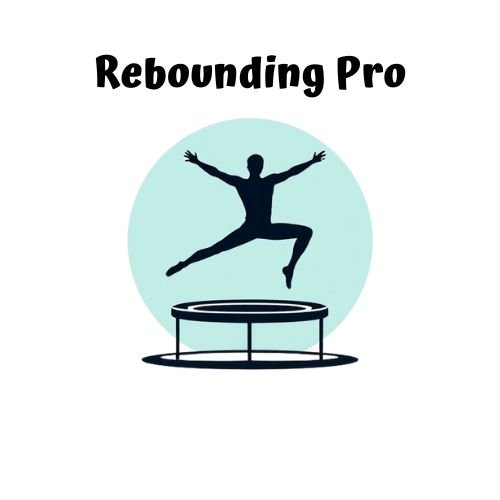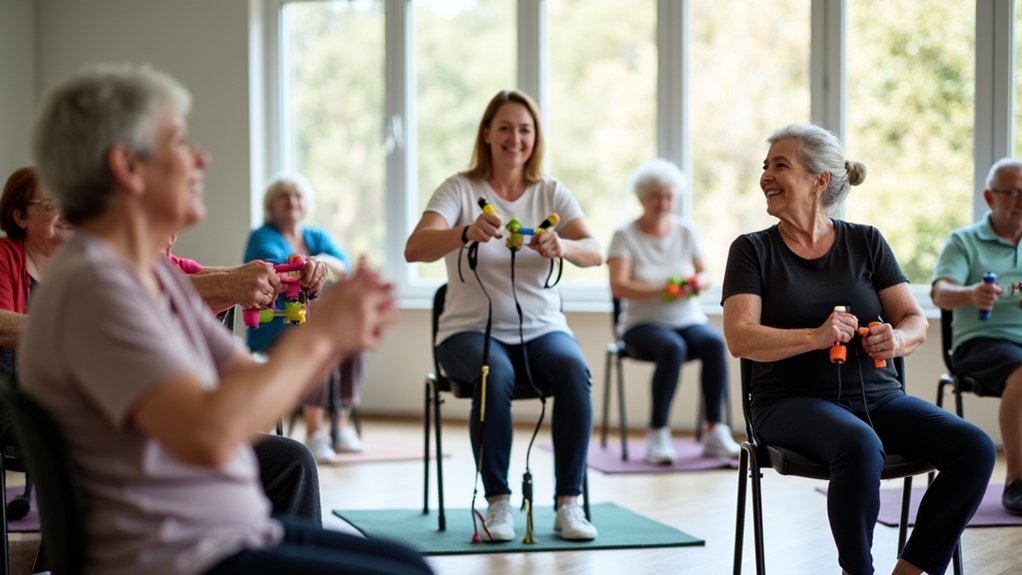Trampoline intervals transform your core fast because they engage your entire midsection simultaneously through constant micro-adjustments on an unstable surface. You’ll activate deep abdominal muscles that traditional exercises miss while combining cardio and strength training in each bounce. This 360° engagement works both upper and lower abs together, delivering in 10 minutes what might take 30 minutes with conventional workouts. Discover how this joint-friendly approach accelerates your core development through proprioceptive benefits.
Why Trampoline Intervals Transform Your Core Fast?

While traditional ab exercises often target isolated muscles, trampoline intervals revolutionize core training by engaging your entire midsection simultaneously.
Your core constantly works to maintain stability as you bounce, twist, and jump, creating continuous activation that builds endurance faster than floor exercises.
The dynamic nature of trampoline workouts means you’re combining cardio benefits with strength training in every session.
When you perform exercises like twisting jumps and tuck jumps, you’re not just burning calories—you’re actively sculpting your obliques and abdominals with each movement.
In just 10 minutes of trampoline intervals, you’ll achieve what might take 30 minutes with conventional workouts.
The unstable surface demands constant core engagement, delivering visible results while protecting your joints from high-impact stress. Coach Ashley Wimoni’s Core Sculpt workout showcases how 10-minute routines can efficiently target core muscles without overwhelming your schedule.
The Science Behind 360° Core Activation on Unstable Surfaces
Your trampoline workouts engage considerably more muscle fibers throughout your core’s 360° structure due to the constant need for stabilization on this highly unstable surface.
Your proprioceptive nervous system kicks into high gear during bouncing movements, sending rapid signals to recruit both deep and superficial core muscles simultaneously.
This neurological response creates a more efficient training environment than stable-surface exercises, as your body must constantly make micro-adjustments to maintain balance while responding to the trampoline’s unpredictable rebound forces. Research indicates that these exercises should be performed with higher repetitions for optimal core endurance development, especially since core muscles contain a significant proportion of Type I aerobic fibers.
Unstable Surface Muscle Recruitment
When exercising on a trampoline, your body encounters a constantly shifting surface that demands extraordinary stabilization from your core muscles. This instability triggers your abdominal and pelvic stabilizers to fire more intensely than they’d on solid ground.
Your transversus abdominis—the deep core muscle essential for spine stability—works overtime during trampoline intervals. Unlike traditional exercises where your rectus abdominis and erector spinae dominate, trampoline workouts activate your entire core as a cohesive unit.
You’ll engage both upper and lower abdominals simultaneously, creating what fitness experts call “holistic core engagement.” This type of training falls within the category of unstable surface exercises that research shows activates deeper stabilizing muscles more effectively than traditional core training methods. This whole-body recruitment pattern isn’t just effective—it’s functional.
Your core serves as a kinetic link between your upper and lower body, reducing injury risk while enhancing athletic performance with every bounce.
Proprioceptive Nervous System Engagement
Beneath every bounce on a trampoline lies a complex neurological symphony that transforms simple movements into powerful core training. Your body’s proprioceptive system—sensing movement, position, and action—engages in a continuous loop between sensory receptors and your nervous system.
When you jump on unstable surfaces, your body:
- Recruits both high and low-threshold motor units, maximizing muscle engagement
- Activates proprioceptive receptors in muscles and joints that provide real-time feedback
- Adapts rapidly to instability by adjusting muscle activity for balance
- Integrates reflexes at the segmental level for coordinated movement
This neurological engagement improves your body awareness and coordination while reducing injury risk. Studies show trampoline training effectively improves somatosensory function similar to effects seen in rehabilitation settings.
The trampoline’s unstable surface forces your nervous system to constantly adjust, creating neural adaptations that transform your core strength more effectively than stable-surface exercises.
How Rebounding Engages Deep Abdominal Muscles Other Workouts Miss

Your body must constantly stabilize against the trampoline’s unpredictable surface, activating deep core muscles that remain dormant during conventional floor exercises.
This challenging environment forces your transverse abdominis—the deepest abdominal layer—to engage continuously through micro-adjustments that maintain balance with each bounce.
Unlike predictable movements in traditional workouts, the multi-directional forces of rebounding create rotational resistance that strengthens your internal obliques while simultaneously recruiting your pelvic floor muscles. According to research, this type of training produces significant improvements in trunk extension strength by 26% after just eight weeks of consistent practice.
Stabilizing Against Unpredictability
Unlike traditional exercise surfaces, trampolines create an environment of constant instability that forces your body to adapt with each bounce. Your core muscles work overtime to maintain balance on the unpredictable elastic surface, engaging deep abdominal muscles that many conventional workouts miss entirely. This form of exercise is especially beneficial as it is low-impact on joints while still delivering highly effective results.
When you’re rebounding, you’re actually training your body’s stabilizing system through:
- Reflexive core activation that happens automatically with each bounce
- Deep muscle engagement that strengthens your entire trunk system
- Constant micro-adjustments that enhance proprioception and balance
- Full-body coordination that integrates your core with every movement
Despite being low-impact, the unpredictable nature of the trampoline surface creates an intense workout for your core stabilizers, making each session more effective than traditional static exercises.
Transverse Activation Mechanics
The transverse abdominis—often called the body’s internal weight belt—responds uniquely to trampoline training in ways traditional exercises simply can’t replicate.
When you bounce, multi-directional movements create rotational forces that your TrA must counteract to prevent unwanted torso twisting.
Unlike floor exercises where adaptation plateaus quickly, your body faces unpredictable surface recoil with each jump. This triggers fast-twitch fiber activation and synchronizes with your pelvic floor muscles during landing.
The three-dimensional loading—especially in the transverse plane—forces your deep core to stabilize against torsional forces that static exercises never produce. Intentionally moving in transverse plane movements during trampoline exercises is crucial for preventing common athletic injuries while maximizing core engagement.
Your TrA remains continuously engaged through eccentric-concentric coupling cycles, creating superior time-under-tension while fascial tissues undergo micro-stretching that traditional crunches miss entirely.
The Metabolic Magic: HIIT Principles Applied to Trampoline Core Training
While traditional workouts often separate cardio and strength training, High-Intensity Interval Training (HIIT) on a trampoline combines both for maximum metabolic impact.
Your body continues burning calories hours after your workout thanks to elevated EPOC (Excess Post-Exercise Oxygen Consumption).
The trampoline intensifies these metabolic benefits while protecting your joints. Trampoline workouts are especially beneficial as they provide low-impact exercise that significantly reduces stress on your knees, ankles, and hips compared to traditional HIIT performed on hard surfaces.
Here’s why this combination works so effectively:
- Time Efficiency – You’ll achieve greater calorie burn in shorter sessions compared to steady-state cardio
- Enhanced Fat Loss – The combination of bouncing and strength movements targets stubborn fat stores
- Improved Insulin Sensitivity – Regular trampoline HIIT helps regulate blood sugar and metabolism
- Progressive Adaptation – Your body continues to respond as you increase intensity and complexity of movements
Beyond Crunches: Multi-Directional Core Strengthening Through Rebounding

Traditional crunches limit core development to a single plane of movement, but trampoline rebounding revolutionizes how we perceive core fitness. While you bounce, all core layers engage simultaneously through three-dimensional movement patterns that demand constant stabilization.
Your body makes micro-adjustments on the unstable surface, activating muscles in ways traditional floor exercises can’t match. Each jump forces your core to respond to gravitational changes during both ascent and descent phases, creating an all-encompassing workout that engages rectus abdominis, obliques, transverse abdominis, and erector spinae muscles together. Rebounders offer exceptional stability with their low-to-the-ground design, making them safe for individual core-focused workouts.
Unlike isolated exercises, rebounding requires your core to coordinate with your limbs, enhancing neuromuscular pathways and proprioception. This functional activation translates directly to improved balance, posture, and everyday movement patterns—benefits you’ll never achieve through endless crunches alone.
Joint-Friendly Power: Maximizing Core Results Without Impact Damage
Unlike high-impact workouts that gradually wear down joints, trampoline intervals deliver exceptional core strengthening benefits while protecting your skeletal system.
The elastic surface absorbs and disperses impact forces away from your joints while directing that energy to your abdominal muscles.
Each bounce triggers micro-movements that activate your deep transverse abdominis muscles through constant stabilization adjustments. Your body’s natural response to the unstable surface builds core strength without the spinal compression common in traditional floor exercises. Strong core provides stability for movement and helps prevent injuries during your trampoline workout.
Try these joint-friendly power moves:
- Single-leg balances to improve pelvic stabilization
- Controlled twist jumps for oblique strength without spinal torque
- Tuck jumps with handlebar support for progressive overload
- Rhythmic bounce patterns for sustained core tension throughout cardio bursts
The Neuromuscular Connection: How Proprioception Amplifies Core Development
The neuromuscular connection between your brain and core muscles forms the foundation of effective trampoline training. Each bounce activates your proprioceptors—sensory receptors that communicate your body’s position to your brain, enhancing muscle activation patterns and joint stabilization.
As you jump, your body constantly adapts to the unstable surface, strengthening these neural pathways. This neuroplasticity effect means you’re not just building muscle—you’re training your nervous system for better coordination and stability.
Trampoline intervals specifically challenge proprioception in ways flat-surface exercises can’t. The dynamic environment forces your core to respond instantly to changing conditions, improving sensorimotor function and fine motor control. Research shows that core muscles provide essential stability for lower limb force production and efficient body movement control.
This translates directly to enhanced athletic performance, with better agility, speed, and power in everyday movements and sports.
Progressive Overload Strategies for Continued Core Development
While initial trampoline sessions yield noticeable core benefits, sustainable progress requires systematic intensity escalation through progressive overload. Your core muscles, like all muscles, adapt to repetitive stimuli, eventually plateauing without increased challenges.
Progressive overload isn’t optional—it’s the essential catalyst transforming temporary trampoline gains into sustainable core strength development.
To maintain your core strength trajectory on the trampoline, implement these proven progression techniques:
- Time Manipulation – Extend your bounce intervals from 30 to 45 seconds while maintaining intensity.
- Movement Complexity – Graduate from basic bounces to knee tucks, twists, and pike jumps that engage deeper core fibers. Monitoring your perceived exertion level during these advanced movements helps determine when you’re ready to progress to even more challenging variations.
- Resistance Addition – Incorporate weighted vests or resistance bands to intensify your routine.
- Rest Reduction – Gradually decrease recovery periods between bounce sets to maintain elevated muscle tension.
Don’t sacrifice form for intensity—proper technique guarantees effective muscle recruitment while preventing potential injuries.
The Recovery Advantage: Why Your Core Bounces Back Faster With Rebounding
Traditional core exercises often leave muscles fatigued for days, but trampoline-based rebounding offers a remarkable recovery advantage that transforms how quickly your core can bounce back between workouts.
The low-impact nature of rebounding minimizes joint stress while maximizing cellular oxygenation, allowing your body to recover more efficiently.
When you integrate Tabata intervals on a trampoline, you’ll experience enhanced muscle resilience as changing gravitational forces strengthen your cells.
Your core muscles adapt to these unique stresses, becoming more efficient at processing nutrients and oxygen between sessions.
Unlike high-impact exercises, rebounding reduces injury risk while improving cardiovascular fitness—a powerful combination that lets you train more frequently with less downtime.
Your metabolism stays elevated, turning your body into a recovery powerhouse that’s ready for the next challenge sooner.
Rebounding effectively engages your abdominal core muscles while simultaneously working your legs, buttocks, and deep back muscles for a comprehensive workout experience.
Frequently Asked Questions
Can Seniors Safely Use Trampoline Intervals for Core Training?
Yes, you can safely use trampoline intervals as a senior. Low-impact rebounding strengthens your core with minimal joint strain. Use handrails for stability, follow supervised routines, and enjoy the 35% balance improvement many seniors experience.
How Do Trampoline Workouts Compare to Pilates for Core Strength?
Trampolines build reactive core strength through dynamic bouncing and constant stabilization, while Pilates offers isolated targeting with precise alignment. You’ll get faster results with trampolines but Pilates provides better postural endurance and precision.
What Size Trampoline Is Optimal for Effective Core Training?
For effective core training, you’ll find a 12-14 foot round trampoline ideal for home use, offering sufficient space and bounce. Mini rebounders (48-inch) work perfectly if you’re limited on space for targeted exercises.
Are There Specific Shoes Recommended for Trampoline Core Workouts?
For trampoline core workouts, wear flat-soled shoes like cheerleading or wrestling footwear that maximize stability and flexibility. You’ll benefit from lightweight options with good grip. Going barefoot enhances proprioception if you’re comfortable with it.
Can Trampoline Intervals Help With Postpartum Diastasis Recti?
Trampoline intervals can help with postpartum diastasis recti, but you’ll need to start gradually. They engage deep core muscles that support recovery, but consult your healthcare provider before beginning any postpartum exercise routine.
In Summary
You’ve now discovered the secret behind trampoline interval training’s core-transforming power. By engaging your deepest abdominal muscles through constant stabilization on an unstable surface, you’re activating 360° core strength while protecting your joints. The combination of HIIT principles, multi-directional movement, and enhanced proprioception creates a perfect environment for rapid core development. Start bouncing today—your stronger, more resilient core awaits!





Leave a Reply